Citroen GRAND C4 PICASSO 2017 2.G Owner's Manual
Manufacturer: CITROEN, Model Year: 2017, Model line: GRAND C4 PICASSO, Model: Citroen GRAND C4 PICASSO 2017 2.GPages: 527, PDF Size: 12.91 MB
Page 141 of 527
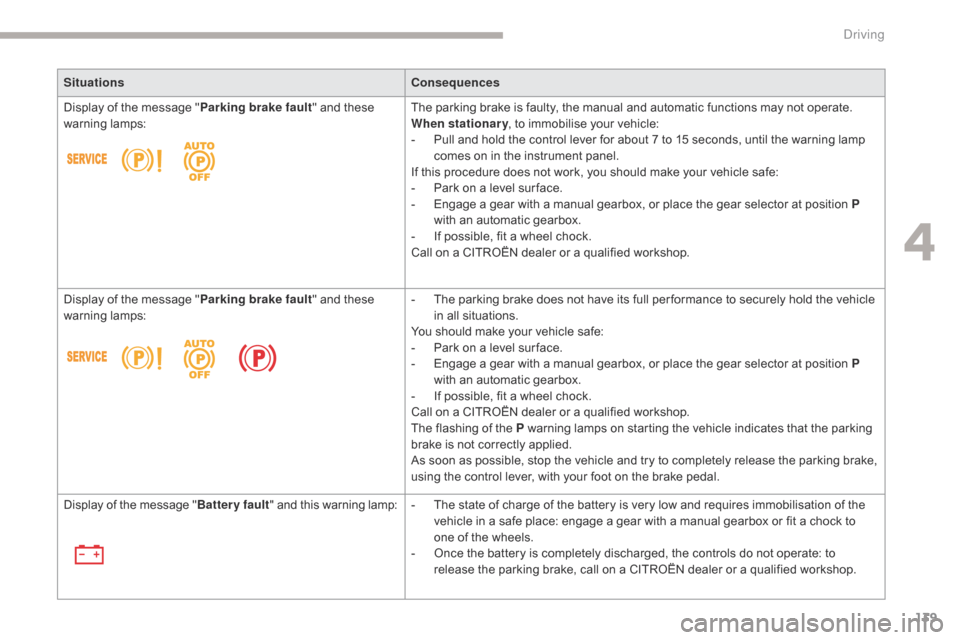
139
C4-Picasso-II_en_Chap04_conduite_ed02-2016
SituationsConsequences
Display of the message " Parking brake fault" and these
warning lamps: The parking brake is faulty, the manual and automatic functions may not operate.
When stationary
, to immobilise your vehicle:
-
P
ull and hold the control lever for about 7 to 15 seconds, until the warning lamp
comes on in the instrument panel.
If this procedure does not work, you should make your vehicle safe:
-
P
ark on a level sur face.
-
E
ngage a gear with a manual gearbox, or place the gear selector at position P
with an automatic gearbox.
-
I
f possible, fit a wheel chock.
Call on a CITROËN dealer or a qualified workshop.
Display of the message " Parking brake fault" and these
warning lamps: -
T
he parking brake does not have its full per formance to securely hold the vehicle
in all situations.
You should make your vehicle safe:
-
P
ark on a level sur face.
-
E
ngage a gear with a manual gearbox, or place the gear selector at position P
with an automatic gearbox.
-
I
f possible, fit a wheel chock.
Call on a CITROËN dealer or a qualified workshop.
The flashing of the P warning lamps on starting the vehicle indicates that the parking
brake is not correctly applied.
As soon as possible, stop the vehicle and try to completely release the parking brake,
using the control lever, with your foot on the brake pedal.
Display of the message " Battery fault" and this warning lamp: -
T
he state of charge of the battery is very low and requires immobilisation of the
vehicle in a safe place: engage a gear with a manual gearbox or fit a chock to
one of the wheels.
-
O
nce the battery is completely discharged, the controls do not operate: to
release the parking brake, call on a CITROËN dealer or a qualified workshop.
4
Driving
Page 142 of 527
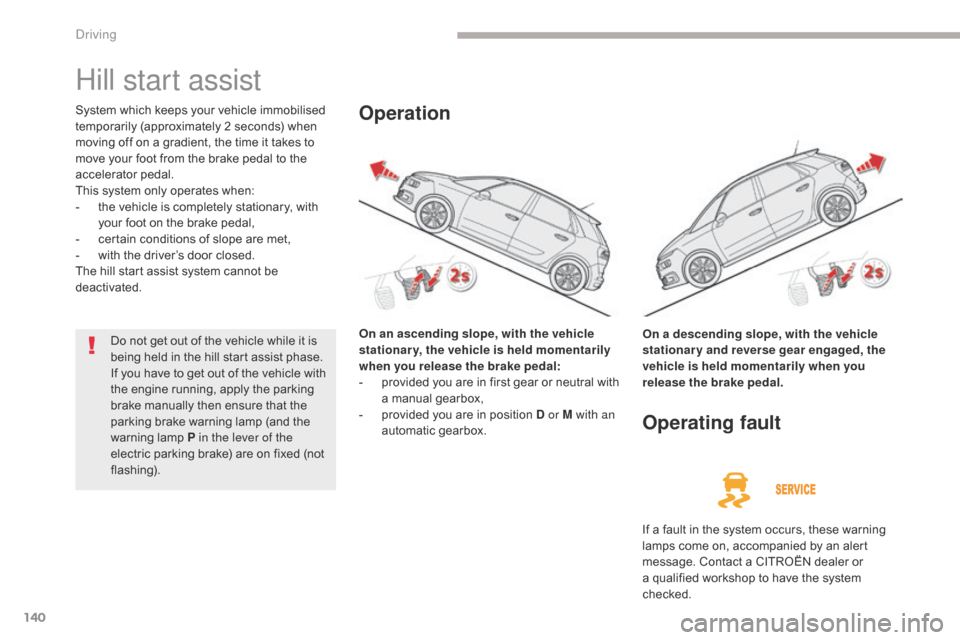
140
C4-Picasso-II_en_Chap04_conduite_ed02-2016
Hill start assist
System which keeps your vehicle immobilised
temporarily (approximately 2 seconds) when
moving off on a gradient, the time it takes to
move your foot from the brake pedal to the
accelerator pedal.
This system only operates when:
-
t
he vehicle is completely stationary, with
your foot on the brake pedal,
-
c
ertain conditions of slope are met,
-
w
ith the driver’s door closed.
The hill start assist system cannot be
deactivated.
On an ascending slope, with the vehicle
stationary, the vehicle is held momentarily
when you release the brake pedal:
-
p
rovided you are in first gear or neutral with
a manual gearbox,
-
p
rovided you are in position D or M with an
automatic gearbox.Operation
On a descending slope, with the vehicle
stationary and reverse gear engaged, the
vehicle is held momentarily when you
release the brake pedal.
Operating fault
If a fault in the system occurs, these warning
lamps come on, accompanied by an alert
message. Contact a CITROËN dealer or
a qualified workshop to have the system
checked.
Do not get out of the vehicle while it is
being held in the hill start assist phase.
If you have to get out of the vehicle with
the engine running, apply the parking
brake manually then ensure that the
parking brake warning lamp (and the
warning lamp
P in the lever of the
electric parking brake) are on fixed (not
flashing).
Driving
Page 143 of 527

141
C4-Picasso-II_en_Chap04_conduite_ed02-2016
5-speed manual
gearbox
Engaging reverse gear
F With the clutch pedal fully down, place the gear lever in neutral.
F
P
ush the gear lever to the right then
backwards.
Only engage reverse gear when the
vehicle is stationary with the engine at idle.
As a safety precaution and to facilitate
starting of the engine:
-
a
lways select neutral,
-
p
ress the clutch pedal.
6-speed manual
gearbox
Engaging 5th or 6th gear
F Move the lever fully to the right to engage 5th or 6th g e a r.
Only engage reverse gear when the
vehicle is stationary with the engine at idle.
As a safety precaution and to facilitate
starting of the engine:
-
a
lways select neutral,
-
p
ress the clutch pedal.
Engaging reverse gear
Failure to follow this advice may cause
permanent damage to the gearbox
(engagement of 3
rd or 4th gear by
m i st a ke).
F
R
aise the ring under the knob and move
the gear lever to the left then for wards.
4
Driving
Page 144 of 527
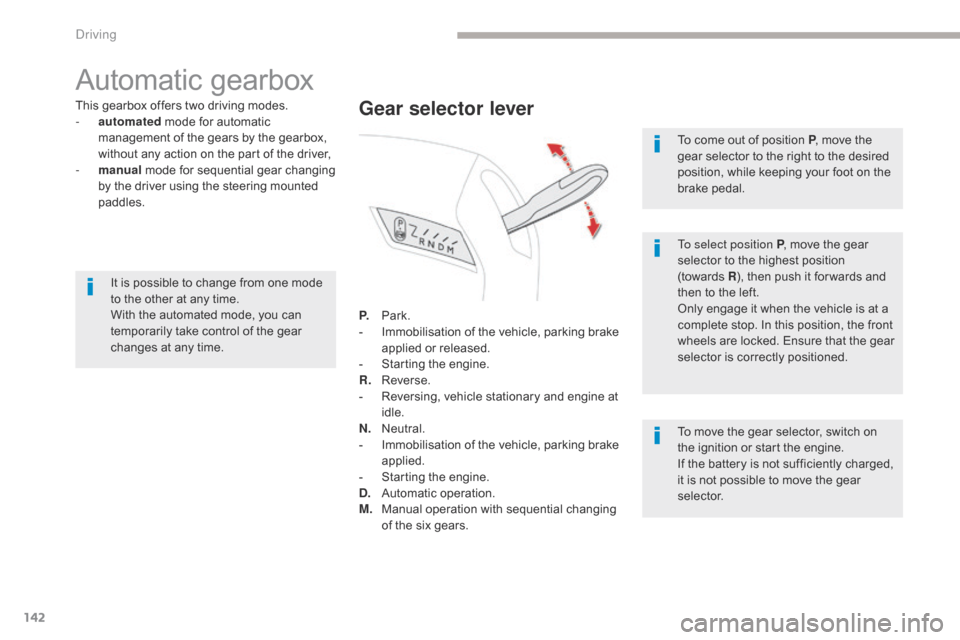
142
C4-Picasso-II_en_Chap04_conduite_ed02-2016
Automatic gearbox
This gearbox offers two driving modes.
- a utomated mode for automatic
management of the gears by the gearbox,
without any action on the part of the driver,
-
m
anual mode for sequential gear changing
by the driver using the steering mounted
paddles.
P.
Pa
rk.
-
I
mmobilisation of the vehicle, parking brake
applied or released.
-
S
tarting the engine.
R.
R
everse.
-
R
eversing, vehicle stationary and engine at
idle.
N.
N
eutral.
-
I
mmobilisation of the vehicle, parking brake
applied.
-
S
tarting the engine.
D.
A
utomatic operation.
M.
M
anual operation with sequential changing
of the six gears.Gear selector lever
To select position P , move the gear
selector to the highest position
(towards
R )
, then push it for wards and
then to the left.
Only engage it when the vehicle is at a
complete stop. In this position, the front
wheels are locked. Ensure that the gear
selector is correctly positioned.
To move the gear selector, switch on
the ignition or start the engine.
If the battery is not sufficiently charged,
it is not possible to move the gear
selector. To come out of position P , move the
gear selector to the right to the desired
position, while keeping your foot on the
brake pedal.
It is possible to change from one mode
to the other at any time.
With the automated mode, you can
temporarily take control of the gear
changes at any time.
Driving
Page 145 of 527
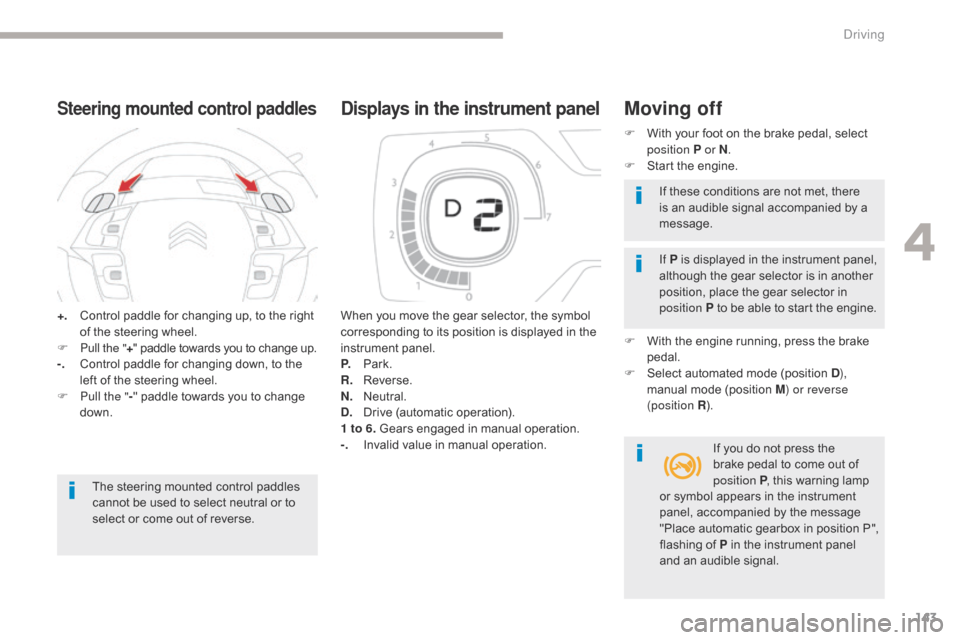
143
C4-Picasso-II_en_Chap04_conduite_ed02-2016
+. Control paddle for changing up, to the right of the steering wheel.
F
P
ull the " +" paddle towards you to change up.
-.
C
ontrol paddle for changing down, to the
left of the steering wheel.
F
P
ull the " -" paddle towards you to change
down.
Steering mounted control paddles
The steering mounted control paddles
cannot be used to select neutral or to
select or come out of reverse. When you move the gear selector, the symbol
corresponding to its position is displayed in the
instrument panel.
P.
Pa
rk.
R.
R
everse.
N.
N
eutral.
D.
D
rive (automatic operation).
1 to 6. Gears engaged in manual operation.
-.
I
nvalid value in manual operation.
Displays in the instrument panelMoving off
F With your foot on the brake pedal, select
position P or N .
F
S
tart the engine.
If P is displayed in the instrument panel,
although the gear selector is in another
position, place the gear selector in
position P to be able to start the engine.
F
W
ith the engine running, press the brake
pedal.
F
S
elect automated mode (position D ),
manual mode (position M) or reverse
(position R ).
If you do not press the
brake pedal to come out of
position P , this warning lamp
If these conditions are not met, there
is an audible signal accompanied by a
message.
or symbol appears in the instrument
panel, accompanied by the message
"Place automatic gearbox in position
P",
flashing of P in the instrument panel
and an audible signal.
4
Driving
Page 146 of 527
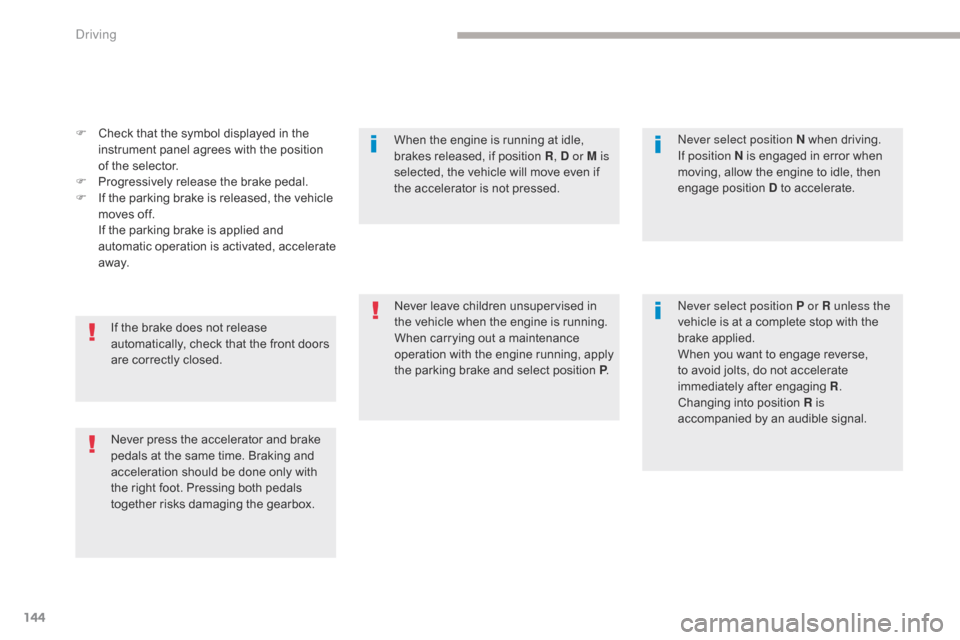
144
C4-Picasso-II_en_Chap04_conduite_ed02-2016
F Check that the symbol displayed in the instrument panel agrees with the position
of the selector.
F
P
rogressively release the brake pedal.
F
I
f the parking brake is released, the vehicle
moves off.
I
f the parking brake is applied and
automatic operation is activated, accelerate
away.
Never press the accelerator and brake
pedals at the same time. Braking and
acceleration should be done only with
the right foot. Pressing both pedals
together risks damaging the gearbox. If the brake does not release
automatically, check that the front doors
are correctly closed. Never leave children unsupervised in
the vehicle when the engine is running.
When carrying out a maintenance
operation with the engine running, apply
the parking brake and select position P
.Never select position P or R unless the
vehicle is at a complete stop with the
brake applied.
When you want to engage reverse,
to avoid jolts, do not accelerate
immediately after engaging R
.
Changing into position R is
accompanied by an audible signal. Never select position N when driving.
If position N
is engaged in error when
moving, allow the engine to idle, then
engage position D to accelerate.
When the engine is running at idle,
brakes released, if position R
, D or M is
selected, the vehicle will move even if
the accelerator is not pressed.
Driving
Page 147 of 527
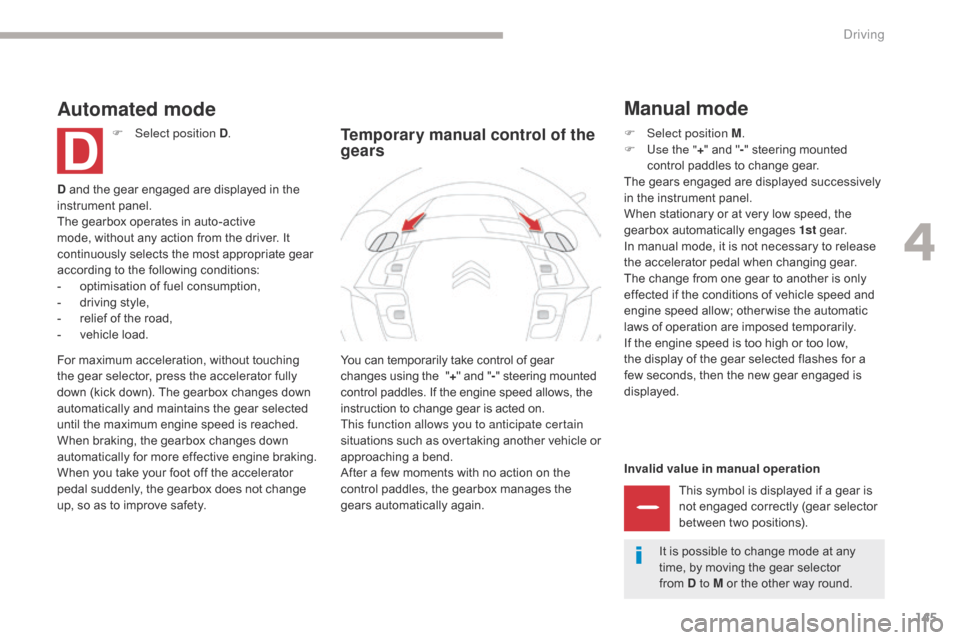
145
C4-Picasso-II_en_Chap04_conduite_ed02-2016
Invalid value in manual operationThis symbol is displayed if a gear is
not engaged correctly (gear selector
between two positions).
You can temporarily take control of gear
changes using the
"
+ " and " -" steering mounted
control paddles. If the engine speed allows, the
instruction to change gear is acted on.
This function allows you to anticipate certain
situations such as overtaking another vehicle or
approaching a bend.
After a few moments with no action on the
control paddles, the gearbox manages the
gears automatically again.
Temporary manual control of the
gears
Manual mode
D and the gear engaged are displayed in the
instrument panel.
The gearbox operates in auto-active
mode, without any action from the driver. It
continuously selects the most appropriate gear
according to the following conditions:
-
o
ptimisation of fuel consumption,
-
d
riving style,
-
r
elief of the road,
-
v
ehicle load.
Automated mode
F Select position D .
For maximum acceleration, without touching
the gear selector, press the accelerator fully
down (kick down). The gearbox changes down
automatically and maintains the gear selected
until the maximum engine speed is reached.
When braking, the gearbox changes down
automatically for more effective engine braking.
When you take your foot off the accelerator
pedal suddenly, the gearbox does not change
up, so as to improve safety. F
Sel ect position M.
F
U
se the "+" and " -" steering mounted
control paddles to change gear.
The gears engaged are displayed successively
in the instrument panel.
When stationary or at very low speed, the
gearbox automatically engages 1st g e a r.
In manual mode, it is not necessary to release
the accelerator pedal when changing gear.
The change from one gear to another is only
effected if the conditions of vehicle speed and
engine speed allow; other wise the automatic
laws of operation are imposed temporarily.
If the engine speed is too high or too low,
the display of the gear selected flashes for a
few seconds, then the new gear engaged is
displayed.
It is possible to change mode at any
time, by moving the gear selector
from
D to M or the other way round.
4
Driving
Page 148 of 527

146
C4-Picasso-II_en_Chap04_conduite_ed02-2016
Before switching off the engine, you can
change to position P or N to be in neutral.
In either case, apply the parking brake to
immobilise the vehicle, unless it is programmed
in automatic mode.
If the lever is not in position P, on opening the
driver's door or approximately 45 seconds after
switching off the ignition there is an audible
signal and a message appears:
F
m
ove the gear selector to position P; the
audible signal stops and the message
disappears.
Operating fault
Whenever parking, you must apply the parking
brake to immobilise the vehicle, if automatic
operation has been deactivated.
Parking the vehicle
In all circumstances, ensure that the
gear selector is in position P before
leaving your vehicle. In the event of a fault with the
gearbox, the service warning lamp
comes on in the instrument panel,
accompanied by a message and an
audible signal.
In this case the gearbox goes into back-up
mode and stays in 3
rd gear. You may then feel
a noticeable jolt when going from P to R and
from
N to R . This jolt does not present any risk
to the gearbox.
Do not exceed 60 mph (100 km/h) while also
observing legal speed limits.
Have it checked by a CITROËN dealer or a
qualified workshop.
In the event of a battery failure, use the
chock to immobilise the vehicle.
Driving
Page 149 of 527
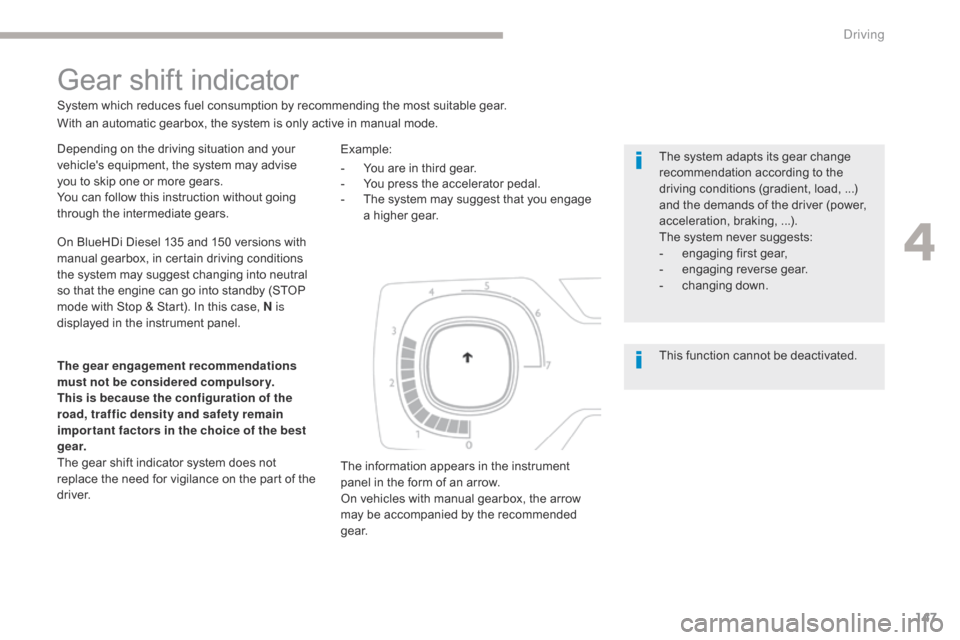
147
C4-Picasso-II_en_Chap04_conduite_ed02-2016
Depending on the driving situation and your
vehicle's equipment, the system may advise
you to skip one or more gears.
You can follow this instruction without going
through the intermediate gears.
Gear shift indicator
System which reduces fuel consumption by recommending the most suitable gear.The system adapts its gear change
recommendation according to the
driving conditions (gradient, load,
...)
and the demands of the driver (power,
acceleration, braking,
...).
The system never suggests:
-
e
ngaging first gear,
-
enga
ging reverse gear.
-
c
hanging down.
The information appears in the instrument
panel in the form of an arrow.
On vehicles with manual gearbox, the arrow
may be accompanied by the recommended
g e a r.
The gear engagement recommendations
must not be considered compulsory.
This is because the configuration of the
road, traffic density and safety remain
impor tant factors in the choice of the best
g e a r.
The gear shift indicator system does not
replace the need for vigilance on the part of the
driver. With an automatic gearbox, the system is only active in manual mode.
On BlueHDi Diesel 135 and 150 versions with
manual gearbox, in certain driving conditions
the system may suggest changing into neutral
so that the engine can go into standby (STOP
mode with Stop & Start). In this case, N is
displayed in the instrument panel. Example:
This function cannot be deactivated.
-
Y
ou are in third gear.
-
Y
ou press the accelerator pedal.
-
T
he system may suggest that you engage
a higher gear.
4
Driving
Page 150 of 527
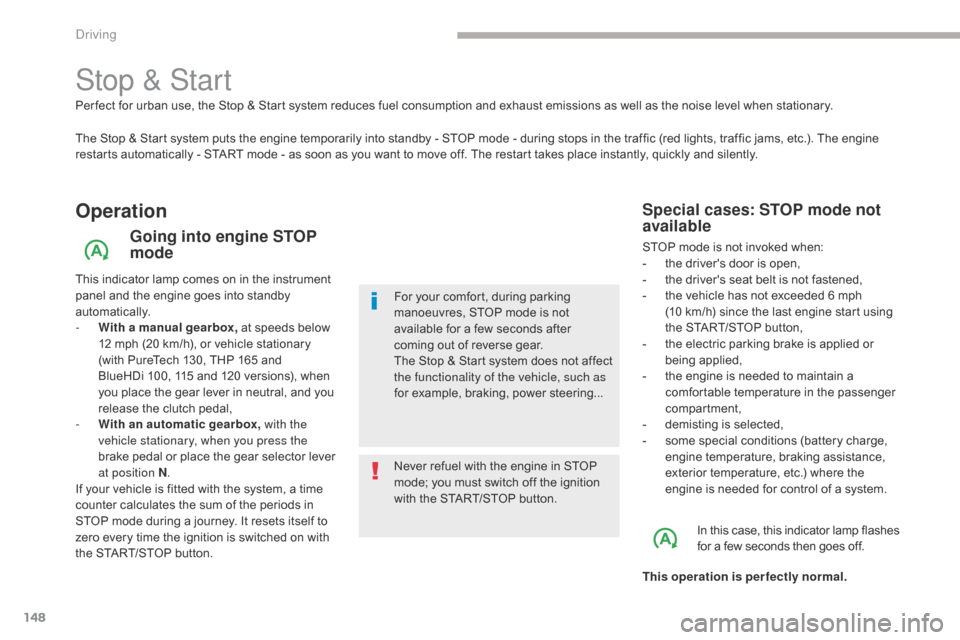
148
C4-Picasso-II_en_Chap04_conduite_ed02-2016
Stop & Start
The Stop & Start system puts the engine temporarily into standby - STOP mode - during stops in the traffic (red lights, traffic jams, etc.). The engine
restarts automatically - START mode - as soon as you want to move off. The restart takes place instantly, quickly and silently.
Operation
Going into engine STOP
mode
This indicator lamp comes on in the instrument
panel and the engine goes into standby
automatically.
-
W
ith a manual gearbox, at speeds below
12 mph (20 km/h), or vehicle stationary
(with PureTech 130, THP 165 and
BlueHDi
100, 115 and 120 versions), when
you place the gear lever in neutral, and you
release the clutch pedal,
-
Wi
th an automatic gearbox, with the
vehicle stationary, when you press the
brake pedal or place the gear selector lever
at position N .
If your vehicle is fitted with the system, a time
counter calculates the sum of the periods in
STOP mode during a journey. It resets itself to
zero every time the ignition is switched on with
the START/STOP button. Never refuel with the engine in STOP
mode; you must switch off the ignition
with the START/STOP button. For your comfort, during parking
manoeuvres, STOP mode is not
available for a few seconds after
coming out of reverse gear.
The Stop & Start system does not affect
the functionality of the vehicle, such as
for example, braking, power steering...
Special cases: STOP mode not
available
STOP mode is not invoked when:
-
t he driver's door is open,
-
t
he driver's seat belt is not fastened,
-
t
he vehicle has not exceeded 6 mph
(10
km/h) since the last engine start using
the START/STOP button,
-
t
he electric parking brake is applied or
being applied,
-
t
he engine is needed to maintain a
comfortable temperature in the passenger
compartment,
-
d
emisting is selected,
-
s
ome special conditions (battery charge,
engine temperature, braking assistance,
exterior temperature, etc.) where the
engine is needed for control of a system.
In this case, this indicator lamp flashes
for a few seconds then goes off.
This operation is perfectly normal.
Per fect for urban use, the Stop & Start system reduces fuel consumption and exhaust emissions as well as the noise level when stationary.
Driving